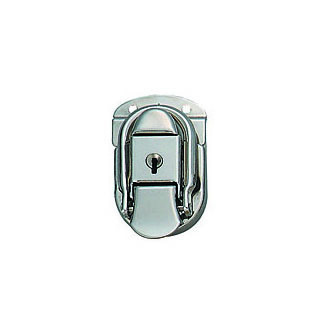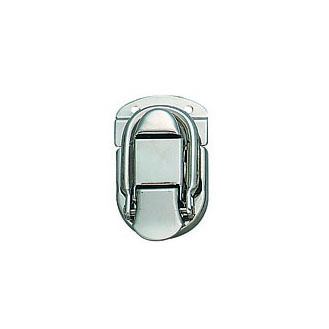Draw Latches
 Draw Latch
Draw Latch
Draw Latches manufacturers
Draw Latch suppliers
Draw Latch companies
Draw Latch distributors
Industrial draw latch manufacturers
Cabinet hardware draw latches
Exploring the Versatility and Functionality of Draw Latches
In the world of hardware and industrial components, there exists a small yet crucial device that often goes unnoticed but plays a significant role in ensuring the security and functionality of various products. This unassuming hero is the "Draw Latch." Let's dive into the world of draw latches, understanding what they are, how they work, and their diverse applications across different industries.
Understanding Draw Latches:
A draw latch, also known as a drawbolt latch, is a type of fastening mechanism used to secure doors, lids, panels, or hinged components. This latch is designed to "draw" two objects together, hence the name. It consists of two main components: a fixed bracket and a moving arm. The fixed bracket is usually attached to a stationary surface, while the moving arm is connected to the door or lid. When the latch is closed, the moving arm engages with the bracket, holding the two surfaces securely together.
Mechanism and Operation:
The beauty of draw latches lies in their simplicity and effectiveness. They operate on a basic mechanical principle, using leverage to create a strong clamping force. When the moving arm is pulled down or rotated, it engages with the bracket, causing the latch to secure the components tightly. To release the latch, a simple upward or rotational movement of the arm disengages it from the bracket, allowing for easy access.
Applications Across Industries:
Draw latches find applications in a wide range of industries, each benefiting from their secure fastening mechanism. Here are a few examples:
Transportation: Draw latches are used in the automotive and aerospace industries to secure compartments, panels, and access doors. They ensure that critical components remain firmly in place during transit or operation.
Industrial Machinery: Machinery doors, covers, and access panels are often secured using draw latches. These latches offer quick and secure closure, making maintenance and repairs more efficient.
Electronics: Draw latches are utilized in electronics cabinets and enclosures to safeguard delicate components from dust, moisture, and unauthorized access.
Furniture: Draw latches are found in foldable furniture, cabinets, and storage units. They allow for easy assembly and disassembly while ensuring stability when in use.
Marine and RV: Draw latches are crucial for securing hatches, storage compartments, and doors on boats, yachts, and recreational vehicles, preventing any unwanted movement during travel.
Medical Equipment: Draw latches ensure the security of medical equipment panels and enclosures, maintaining a sterile environment and safeguarding sensitive instruments.
Outdoor Equipment: They are used in outdoor gear such as toolboxes, camping equipment, and storage containers, providing durable and reliable closure mechanisms.
Innovation and Customization:
As industries evolve, so do draw latches. Manufacturers constantly innovate, creating variations with specialized features such as adjustable tension, lockable options, corrosion resistance, and even integrated electronic sensors for monitoring. This adaptability allows draw latches to meet the unique requirements of different applications.
In conclusion, the draw latch may be small in size, but its impact is immense. From ensuring the security of panels in industrial settings to safeguarding electronics and furniture, this unassuming fastening mechanism is the unsung hero of various industries. Its simplicity, reliability, and adaptability make it an indispensable component, quietly playing a crucial role in keeping our world connected and secure.
 Draw Latch
Draw Latch
In the realm of mechanical ingenuity, it's often the simplest designs that have the most profound impact. One such unassuming yet highly functional invention is the draw latch. Let's embark on a journey to uncover the significance, mechanics, and versatile applications of this uncelebrated hero of the hardware world.
Unveiling the Draw Latch:
At first glance, a draw latch might appear as just another piece of hardware, but beneath its unpretentious exterior lies a mechanism that performs an essential task – securely fastening two components together. Comprising two key parts – a fixed bracket and a movable arm – this latch uses the principle of leverage to create a powerful clamping force. Its purpose is to "draw" two objects together and hold them firmly in place.
Mechanics in Motion:
The brilliance of draw latches lies in their simplicity. When the movable arm is engaged with the fixed bracket, the clamping action takes effect, creating a strong and reliable hold. To release the latch, a straightforward movement disengages the arm from the bracket, providing quick and easy access.
Multifaceted Utility:
Draw latches find their place in numerous industries, each benefiting from their unique design and secure functionality:
Automotive and Aerospace: These latches ensure that doors, panels, and access points remain sealed during the rigors of transportation, safeguarding sensitive equipment.
Industrial Equipment: Draw latches simplify maintenance and repair by securing machinery panels and components, making them easy to access when needed.
Electronics Enclosures: Delicate electronics are shielded from the elements and unauthorized access by draw latches in cabinets and enclosures.
Furniture and Cabinetry: Foldable furniture, cabinets, and storage units owe their stability to draw latches, allowing for easy assembly and secure closure.
Marine and Recreational Vehicles: In the world of boating and RVs, draw latches keep hatches and doors secure, ensuring a worry-free journey.
Healthcare Equipment: Draw latches contribute to the integrity of medical equipment, safeguarding sensitive instruments and maintaining a sterile environment.
Outdoor Gear: Toolboxes, camping equipment, and storage containers benefit from the durability and reliability of draw latches in rugged conditions.
Evolving Innovation:
As industries evolve, draw latches have not remained stagnant. Manufacturers continually innovate, offering features like adjustable tension, corrosion resistance, lockable options, and even electronic sensors for monitoring. This adaptability ensures that draw latches can be tailored to meet the unique demands of various applications.
Invisible Heroes:
In a world often captivated by complex technological advancements, it's easy to overlook the draw latch – a quiet achiever in the realm of hardware. Its straightforward design and steadfast reliability make it an unsung hero, upholding the integrity of countless products across diverse industries.
In summary, the draw latch may be a modest component in the grand scheme of things, but its impact is significant. Its ability to securely fasten and hold objects together ensures the functionality and security of numerous products we encounter daily. As we appreciate the intricate mechanisms and innovative adaptations that shape our world, let us not forget to give credit to the humble draw latch – an invisible hero working diligently behind the scenes.
In the intricate world of hardware and engineering, it's often the simplest of innovations that have the most profound impact. Enter the draw latch – a seemingly unremarkable yet essential component that quietly plays a crucial role in various industries. Join us as we delve deeper into the world of draw latches, understanding their mechanics, applications, and the reasons behind their widespread use.
A Closer Look at Draw Latches:
At first glance, a draw latch might appear deceptively simple – a modest piece of hardware that connects two objects. However, its design conceals an ingenious mechanism that ensures secure fastening and reliable closure. A draw latch typically comprises two primary components: a fixed bracket and a movable arm. When engaged, the movable arm pulls the two objects together, creating a tight and secure connection.
Mechanics in Action:
The draw latch's brilliance lies in its mechanical simplicity. When the movable arm is engaged with the fixed bracket, a powerful clamping force is generated, effectively holding the components in place. Releasing the latch is as straightforward as disengaging the arm from the bracket, providing immediate access with minimal effort.
Diverse Applications:
Draw latches are unsung heroes in a multitude of industries, each relying on their reliable functionality for different purposes:
Transportation Industry: Whether it's the automotive or aerospace sector, draw latches keep doors, panels, and compartments securely shut during movement, ensuring the safety of contents and personnel.
Industrial Settings: In the realm of machinery and equipment, draw latches simplify maintenance by securing access panels and doors, facilitating quick and hassle-free inspections and repairs.
Electronics Enclosures: Delicate electronics find protection within enclosures secured by draw latches, shielding sensitive components from dust, moisture, and unauthorized access.
Furniture and Cabinetry: Draw latches provide stability to foldable furniture, cabinets, and storage units, enabling easy assembly and secure closure.
Marine and Recreational Vehicles: These latches maintain the integrity of hatches, doors, and storage compartments in boats and RVs, ensuring a secure journey.
Healthcare Sector: In medical equipment, draw latches preserve the sterility of instruments and maintain a controlled environment within equipment enclosures.
Outdoor Gear: Toolboxes, camping equipment, and storage containers rely on draw latches to endure rugged outdoor conditions while keeping contents secure.
Evolving Design and Innovation:
Draw latches are not stagnant inventions; they evolve alongside technological advancements. Manufacturers continuously innovate by introducing features like adjustable tension, lockable options, corrosion resistance, and more. This adaptability allows draw latches to cater to specific requirements across various industries.
Conclusion:
In the world of hardware, it's the draw latch's quiet reliability that has earned it a place of significance. Its unassuming design and straightforward functionality belie its vital role in diverse industries. As we marvel at intricate machines and cutting-edge technologies, let's not forget to appreciate the humble draw latch – an understated yet indispensable element that ensures security, functionality, and convenience in the products we interact with every day.
In the intricate tapestry of industrial hardware, some components remain hidden gems, quietly contributing to the efficiency and security of countless products. Among these unsung heroes is the draw latch – a seemingly modest device that wields immense power when it comes to fastening and securing. Join us as we uncover the world of draw latches, from their mechanism to their diverse applications across industries.
Unveiling the Draw Latch:
A draw latch, often referred to as a drawbolt latch, operates on a deceptively simple principle: drawing two objects together with a clamping force. Its fundamental design consists of two primary components: a fixed bracket and a moving arm. The arm engages with the bracket, creating a secure connection that holds two surfaces in place.
The Mechanics Behind the Magic:
The elegance of draw latches lies in their mechanics. When the moving arm is engaged with the fixed bracket, the force exerted draws the components closer, creating a tight bond. Releasing the latch is a matter of disengaging the arm, offering swift access with minimal effort.
Versatile Applications:
The draw latch's versatility spans a range of industries, each benefiting from its dependable fastening capabilities:
Transportation Industry: Draw latches secure doors, panels, and compartments in vehicles and aircraft, preventing unexpected openings during transit.
Industrial Machinery: Access panels and doors of industrial machines are held securely by draw latches, allowing for quick maintenance and hassle-free inspections.
Electronics Protection: Delicate electronics find refuge within enclosures secured by draw latches, guarding against external elements and unauthorized access.
Furniture and Storage: Draw latches ensure stability in foldable furniture and storage units, enabling effortless assembly and secure storage.
Marine and RVs: Hatches, doors, and storage compartments in boats and recreational vehicles are kept secure by draw latches, even in turbulent conditions.
Healthcare Sector: Draw latches play a vital role in maintaining a sterile environment within medical equipment enclosures, safeguarding precision instruments.
Outdoor Gear: Toolboxes, camping equipment, and storage containers rely on draw latches to withstand outdoor challenges while keeping contents safe.
The Evolution of Draw Latches:
Just like any innovative technology, draw latches have evolved over time. Manufacturers have introduced features like adjustable tension, corrosion resistance, and lockable options to cater to diverse needs.
In Conclusion:
While draw latches may seem small and unassuming, their impact is far-reaching. These uncelebrated heroes of hardware keep our belongings secure, our industries efficient, and our products functional. As we marvel at the complex systems of our modern world, let's remember to appreciate the draw latch – a testament to how simplicity can lead to profound impact.